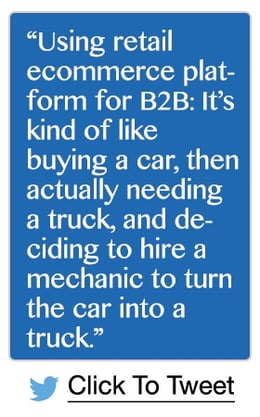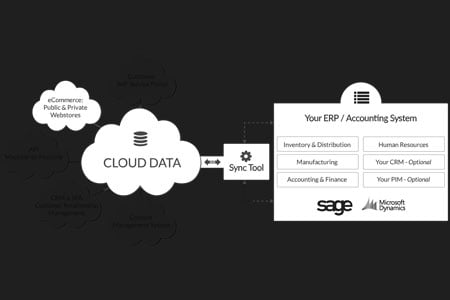The Story Behind Our Growth, Part II

- Inc. 5000 Fastest Growing (5 straight years)
- SC Fastest Growing
- SC Roaring Twenties
In part one, we looked at the mechanics of our growth, including a company focus, building a great team, and leadership traits. In this post, we'll look at why our chosen focus of ERP-integrated ecommerce positions us well for future growth.
Changes will continue in the software industry
The last fifteen years have seen remarkable changes in the B2B software industry. All the major software categories that help companies get, keep, and grow their customers are colliding. Most companies have all of their business data locked in their on-premise back office ERP (Enterprise Resource Planning: financial and inventory software) system. For B2B companies, that business data (and the associated processes) is very complex. The on-premise ERP systems have served them well, but problems occur when they try to expand access to that business data (for inquiries and transactions) to customers and reps that are spread all over the world.
Customers today demand more than ever, and customer service must evolve to match those demands. Can you imagine having to go back to using travel agents to book all of your travel? Or waiting in line at the box office for concert tickets? It’s painful to think about, but that’s where the underserviced small to mid-sized B2B market is today.
Opportunities from problems
These problems have created opportunities, but the solutions being developed are creating lots of gaps and overlaps. It began with the rapid growth of venture-backed cloud-based SaaS ( Software as a Service) companies like NetSuite and SalesForce. The pot has been further stirred by the rapid adoption of popular ecommerce platforms like Magento (now owned by eBay).
Magento
Ecommerce products like Magento have gained market share very quickly, and provide lots of benefits for companies that sell retail, but these tools are not designed for B2B activity.
 For example, the key identifier for a customer is the email address in retail ecommerce platforms. If that sounds like a B2C way of thinking, that’s because it is. The bigger challenge is that thousands of other software engineering assumptions cascade from that single decision (email address as primary identifier), and that doesn’t work for B2B. As a result, it’s almost a ground-up rebuild to get it to work for B2B companies. It’s kind of like buying a car, then actually needing a truck, and deciding to hire a mechanic to turn the car into a truck. It might look cool on Pimp My Ride, but in the real world, for small and medium sized businesses, who need that truck for on-time deliveries, it ends up not being all that cool. Even if the company is successful in getting a “frankenstein” system online, they have to actually live with it and maintain it.
For example, the key identifier for a customer is the email address in retail ecommerce platforms. If that sounds like a B2C way of thinking, that’s because it is. The bigger challenge is that thousands of other software engineering assumptions cascade from that single decision (email address as primary identifier), and that doesn’t work for B2B. As a result, it’s almost a ground-up rebuild to get it to work for B2B companies. It’s kind of like buying a car, then actually needing a truck, and deciding to hire a mechanic to turn the car into a truck. It might look cool on Pimp My Ride, but in the real world, for small and medium sized businesses, who need that truck for on-time deliveries, it ends up not being all that cool. Even if the company is successful in getting a “frankenstein” system online, they have to actually live with it and maintain it.
NetSuite
NetSuite’s business has exploded because they opened up a web-based front office for B2B companies to use with their customers and sales reps. That front office happens to be coupled with the back office. The challenge they routinely run into is that companies have to rip out their entire back office (their existing ERP system) to get that front office. It's a bit like changing the engine on a single-engine airplane, while still flying the plane - most small to mid-sized companies can’t afford to do that. The software cost alone is expensive, but the implementation costs and disruption to the business trying to make the switch are gigantically more expensive and risky.
SalesForce
SalesForce has become the largest SaaS company in the world by building the sales rep-facing piece of the front office. It’s been a wildly successful platform for companies of all sizes. For small to mid-sized B2B companies, however, the SF implementation is completely disconnected from their ERP (and all of their business data). If you can get a good SalesForce developer to answer your phone call, you might be able to get them to write a home-made integration for you to connect their front office platform to your back office ERP, but it will provide limited value to your actual customers (for self-service). Plus, you can throw your SalesForce “No Software” button away, because it going to get really expensive.
The Website Pipeline front office
Website Pipeline’s front office ecommerce software suite is right in the middle of the collision of ecommerce, customer self-service, CRM, and sales force automation for small to mid-sized B2B companies, and I am very optimistic about where we stand. Big (positive) change is coming for small to mid-size manufacturers and distributors who primary sell to other businesses (B2B companies). We live in an age where 15,000 cars per week are being purchased on eBay via smartphones, yet the overwhelming majority of small to mid-sized B2B companies are still performing all of their sales and customer service activities via phone, fax, and email. It happens one transaction at a time and only during business hours.
These businesses are stuck in the 1980’s, and it’s not ideal for their customers, having to operate this way, plus it’s expensive and inefficient. There is a huge gap between what we all do on our smartphones everyday as consumers, and the way we interact as B2B companies in business. It’s not easy, but we believe Website Pipeline’s mission is to close that gap for manufacturers and distributors. Anyway you slice it, change is coming, and the ride is going to be very interesting.






